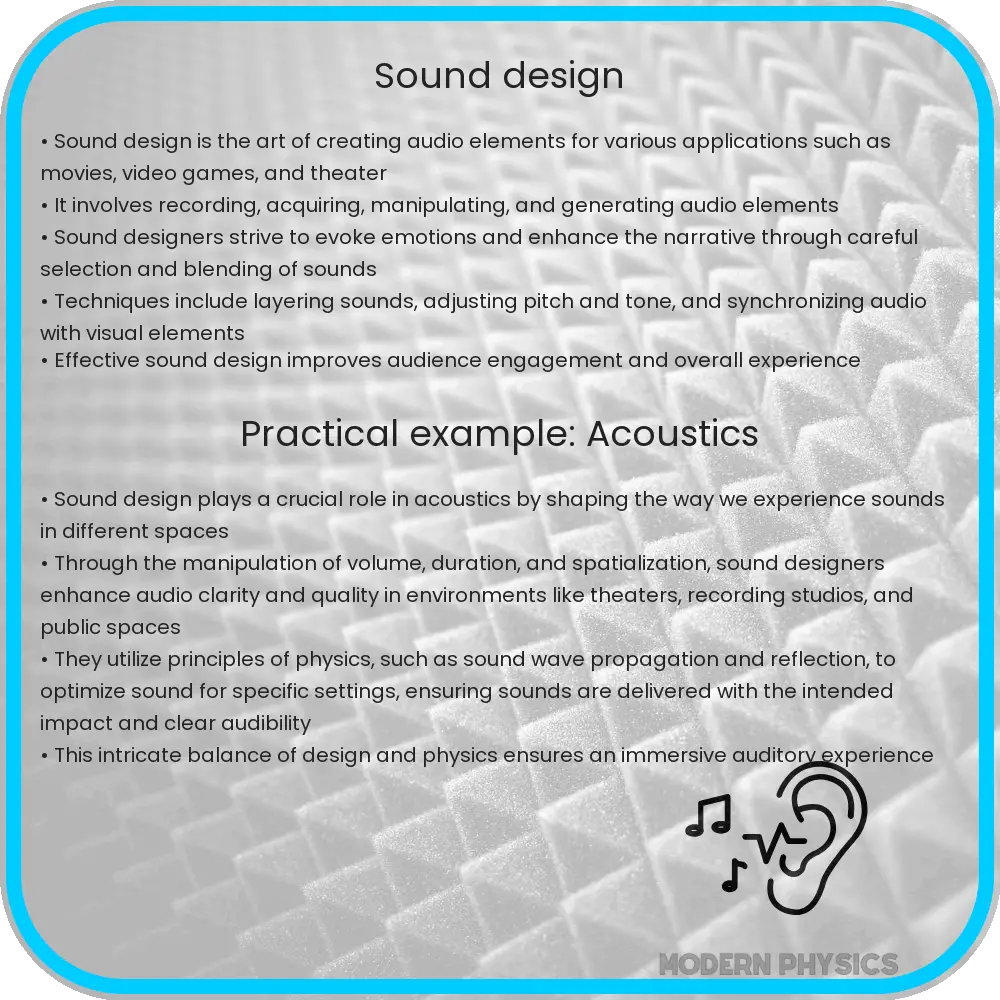Learn about sound design and acoustics, the art and science of creating and managing sound across various media industries.

Introduction to Sound Design and Acoustics
Sound design is an essential field of study that involves the creation and manipulation of audio elements. It plays a critical role in various industries such as film, television, music production, and video game development. The core of sound design lies in acoustics, the science of sound, which helps professionals understand how sound behaves in different environments and how it can be harnessed and shaped to achieve desired effects.
Understanding Acoustics
Acoustics is the branch of physics focused on the study of sound. It encompasses the generation, transmission, and reception of sound waves. Sound waves are vibrations that travel through a medium such as air, water, or solids. Understanding how sound waves behave in different media and environments is crucial for creating optimal audio experiences.
- Frequency and Pitch: The frequency of a sound wave affects its pitch. Higher frequencies produce higher pitches, while lower frequencies result in lower pitches.
- Amplitude and Loudness: Amplitude refers to the strength or intensity of a sound wave. Greater amplitude results in louder sounds.
- Timbre: Also known as tone color, timbre is the quality of sound that distinguishes different types of sound production, such as instruments or voices, even when they have the same pitch and loudness.
By manipulating these properties, sound designers can create a wide array of auditory experiences, making sound a powerful tool for storytelling and atmosphere creation in media.
Techniques in Sound Design
Sound design is not just about recording natural sounds but also involves a lot of creativity and technical skills. Here are key techniques used in the field:
- Sampling: This technique involves recording real-world sounds to be edited and manipulated digitally. These sounds can be altered in pitch, duration, or timbre to suit specific needs.
- Synthesis: Sound synthesis is the process of generating sound from scratch, typically using synthesizers or computer-based tools. This allows designers to create unique sounds that do not naturally occur in the environment.
- Effects Processing: Various effects can be applied to sounds to enhance or alter their quality. Common effects include reverb, delay, distortion, and filtering.
These techniques empower sound designers to tailor sounds specifically to the emotional tone and style of a project, enhancing the overall sensory experience for the audience.
The Role of Audio Engineering
While sound design focuses on the artistic aspects of sound creation, audio engineering deals more with the technical side. Audio engineers work on the recording, mixing, and production of sound, ensuring high-quality audio output. They utilize sophisticated equipment and software to capture sound accurately and mix it to achieve the best possible balance and clarity.
Audio engineers must have a thorough understanding of acoustics to effectively manipulate sound. They play a crucial role in:
- Microphone Technique: Choosing the right type of microphone and positioning it correctly can greatly impact the quality of recorded sound.
- Mixing: Balancing different audio tracks to create a harmonious final product is an art form in itself, requiring careful adjustment of levels, panning, and effects.
Modern Applications and Technologies in Sound Design and Acoustics
With advancements in technology, the field of sound design and acoustics has seen significant innovations that have transformed how audio is produced and consumed. Key technologies include:
- 3D Audio: This technology creates a three-dimensional soundscape, allowing listeners to perceive sound from various directions and distances, enhancing the realism of the audio experience.
- Virtual Reality (VR) and Augmented Reality (AR): In VR and AR, sound plays a pivotal role in creating an immersive environment. Here, spatial audio techniques are used to place sounds accurately within a three-dimensional space.
- Machine Learning: AI and machine learning are being used to automate certain aspects of sound design, such as sound classification and audio effect recommendation, speeding up the production process and increasing efficiency.
These technologies not only enhance the listeners’ experience but also open up new possibilities for creators, allowing them to explore novel ways of storytelling through sound.
Conclusion
Sound design and acoustics represent a fascinating intersection of art and science. By understanding the properties of sound waves—frequency, amplitude, and timbre—and mastering sound design techniques like sampling, synthesis, and effects processing, professionals can create compelling auditory experiences. Moreover, with the support of cutting-edge technologies such as 3D audio and machine learning, sound designers and audio engineers continue to push the boundaries of what’s possible in both entertainment and practical applications.
Whether it’s in movies, video games, or virtual reality, effective sound design enhances the emotional engagement and enjoyment of audiences worldwide. As technologies advance, the field of sound design and acoustics will continue to evolve, promising even more exciting opportunities for creative expression and technical innovation in the future.
